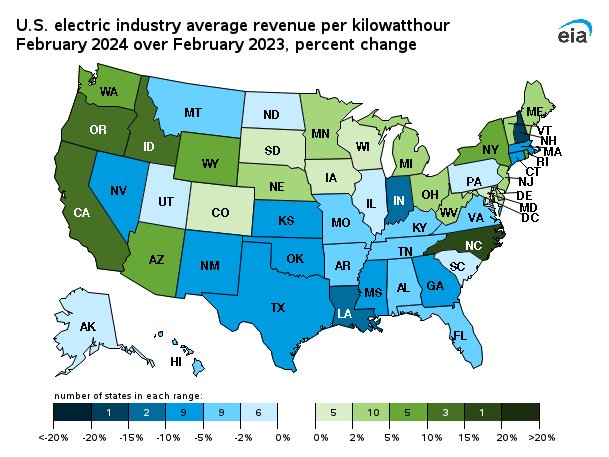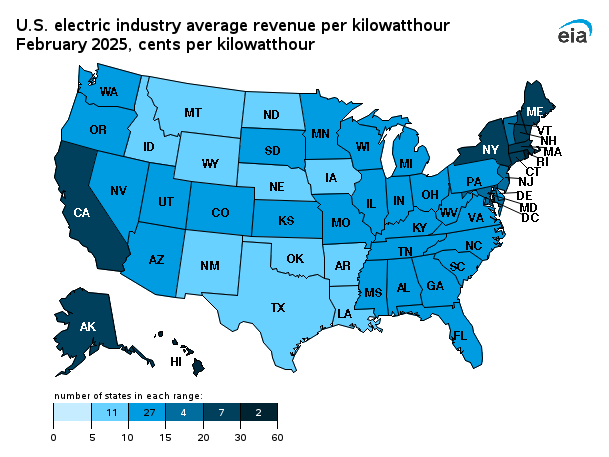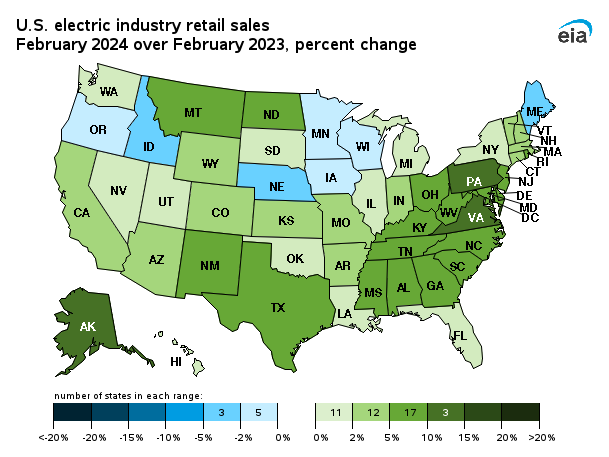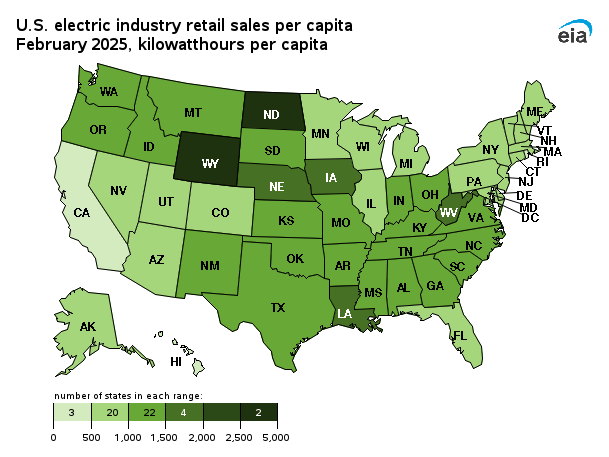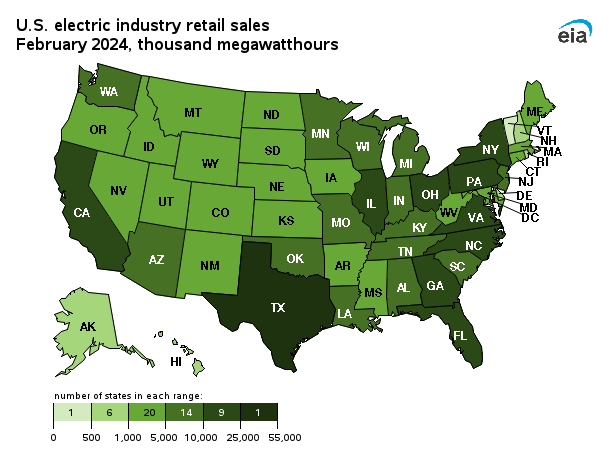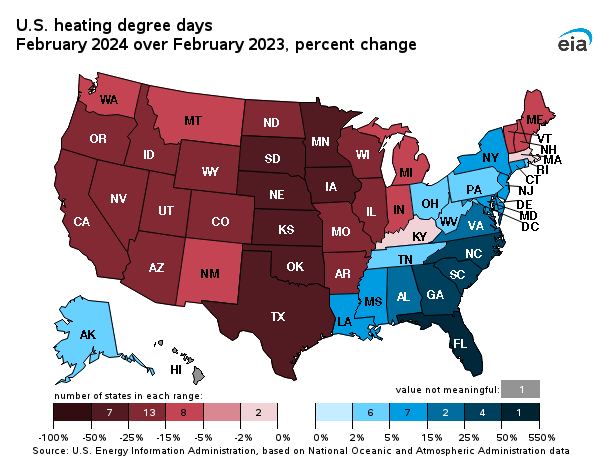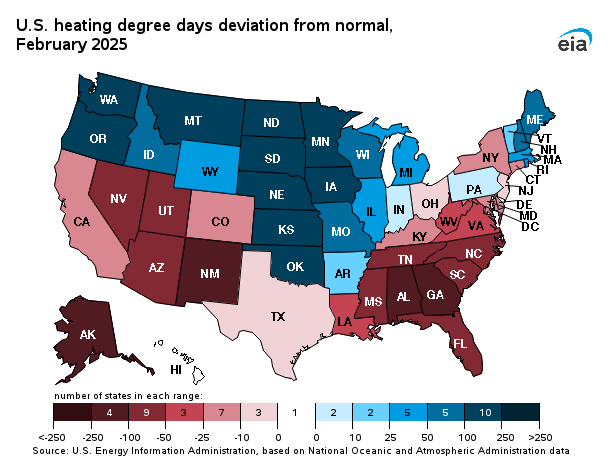
Electricity Monthly Update
End Use: October 2025
Retail rates/prices and consumption
In this section, we look at what electricity costs and how much is purchased. Charges for retail electric service are based primarily on rates approved by state regulators. However, a number of states have allowed retail marketers to compete to serve customers and these competitive retail suppliers offer electricity at a market-based price.
EIA does not directly collect retail electricity rates or prices. However, using data collected on retail sales revenues and volumes, we calculate average retail revenues per kWh as a proxy for retail rates and prices. Retail sales volumes are presented as a proxy for end-use electricity consumption.
Average revenue per kWh by state
Forty-four states and the District of Columbia saw increased revenue per kilowatt-hour (kWh) compared to last October, while average revenue per kWh increased by 5.2% on a national basis. The largest percent increase was in the District of Columbia, up 25.8%, followed by Maryland, up 18.4%, and Pennsylvania, up 17.5%. Average revenue per kWh figures decreased in six states compared to last year. The largest percent decrease was in Connecticut, down 8.1%, followed by Nevada, down 7.9%, and Hawaii, down 2.8%. In the contiguous US, California, Rhode Island, and Massachusetts had the highest average revenues at 28.32, 26.19, and 24.82 cents per kWh, respectively. North Dakota, New Mexico, and Iowa had the lowest average revenues at 8.04, 8.81, and 8.89 cents per kWh, respectively.
| Average Revenues/Sales (¢/kWh) | Retail Sales (thousand MWh) | |||||||||||||||||||||||||||||||||||||||||||||||||||||||||||||||||||||||||||||||||||||||||||||||||
|---|---|---|---|---|---|---|---|---|---|---|---|---|---|---|---|---|---|---|---|---|---|---|---|---|---|---|---|---|---|---|---|---|---|---|---|---|---|---|---|---|---|---|---|---|---|---|---|---|---|---|---|---|---|---|---|---|---|---|---|---|---|---|---|---|---|---|---|---|---|---|---|---|---|---|---|---|---|---|---|---|---|---|---|---|---|---|---|---|---|---|---|---|---|---|---|---|---|---|
| End-use sector | October 2025 | Change fromOctober 2024 | October 2025 | Change fromOctober 2024 | Year to Date | |||||||||||||||||||||||||||||||||||||||||||||||||||||||||||||||||||||||||||||||||||||||||||||
| Residential | 17.98 | 5.2% | 106,976 | 0.8% | 1,286,595 | |||||||||||||||||||||||||||||||||||||||||||||||||||||||||||||||||||||||||||||||||||||||||||||
| Commercial | 13.41 | 4.0% | 125,632 | 3.9% | 1,249,121 | |||||||||||||||||||||||||||||||||||||||||||||||||||||||||||||||||||||||||||||||||||||||||||||
| Industrial | 8.65 | 6.7% | 88,018 | -0.4% | 879,667 | |||||||||||||||||||||||||||||||||||||||||||||||||||||||||||||||||||||||||||||||||||||||||||||
| Transportation | 13.57 | 9.2% | 589 | 4.1% | 6,134 | |||||||||||||||||||||||||||||||||||||||||||||||||||||||||||||||||||||||||||||||||||||||||||||
| Total | 13.63 | 5.2% | 321,216 | 1.7% | 3,421,517 | |||||||||||||||||||||||||||||||||||||||||||||||||||||||||||||||||||||||||||||||||||||||||||||
| Source: U.S. Energy Information Administration | ||||||||||||||||||||||||||||||||||||||||||||||||||||||||||||||||||||||||||||||||||||||||||||||||||
Total average revenues per kilowatt-hour (kWh) increased by 5.2% from last October, to 13.63 cents/kWh in October 2025. All four sectors saw increases in average revenues per kWh compared to last October. The Transportation sector saw the highest increase, up 9.2%, then the Industrial sector, up 6.7%, the Residential sector, up 5.2%, and finally the Commercial sector, up 4.0%. On a nationwide basis, retail sales increased by 1.7% in October 2025 compared to last October, with three sectors seeing increases. The Transportation sector saw the largest increase in retail sales from last October, up 4.1%, followed by the Commercial sector, up 3.9%, and the Residential sector, up 0.8%. The Industrial sector was down 0.4%.
Retail sales
Thirty-nine states and the District of Columbia saw an increase in retail sales volume in October 2025 compared to last October. Arkansas had the highest year over year percent increase in retail sales, up 7.5%, followed by Indianna, up 7.6%, and Nebraska, up 6.3%. Eleven states saw a decrease in retail sales volume compared to last year. Rhode Island had the highest year over year percent decrease, down 13.4%, followed by Nevada, down 10.2%, and California down 5.7%.
Forty-five states and the District of Columbia saw an increase in HDDs compared to last October. Florida had the highest year over year percent increase, up 133%, followed by Texas, up 73%, and California up 58%. Four states saw a decrease in HDDs from last October. Arizona had the highest percentage year over year decrease, 74%, followed by Alaska, down 14%, and Massachusetts, down 1%.
